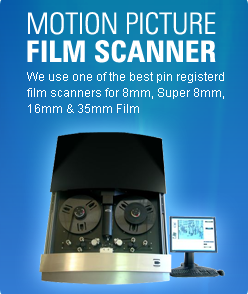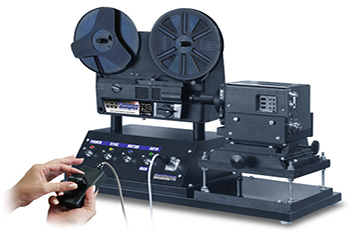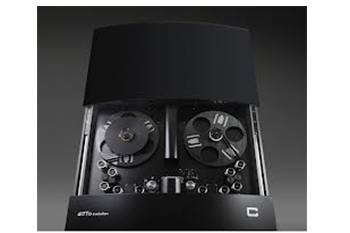
Film Conversion Equipment
Film Scanning and Film Transfer Equipment Types
The type of film scanning machine used for your 8mm, Super 8 or 16mm film conversion will have as much of an impact on the quality you receive as the resolution of the scan itself will. For example, if you wanted to digitize a photograph and tried doing it two different ways. You first put the photograph down on a table and took a picture of it using your smart phone or camera. Then you took the picture and scanned it using a flatbed scanner. If you compare the two side by side on your computer it will become really obvious that the flatbed scanner produced a digital image as good as the photograph. However, the picture you took with your phone or camera does not look close to the quality of the original photograph.
The same goes for scanning your 8mm, Super 8 or 16mm film. The real-time and frame by frame machines below are using a camcorder to take a picture of your film. The motion picture film scanner and Datacine machine are scanning the film. The results will be significantly different.
Film Conversion Equipment |
|
Real Time
|
|
Frame by Frame
|
|
Professional Film Scanners
|
|
Equally important as resolution is the type of film transfer. There are a few basic types of film transfer processes. More than 80% of the companies out there today use a real-time transfer. Any type of real-time film transfer will result in video that is 40-50% worse than the film’s current condition.
The film transfer processes above are the basics types and do not include any restoration by themselves. Restoration comes in many different capabilities from color and exposure correction, to grain elimination, to stabilization
Sterling Heights Fun Facts: Sterling Heights is serviced by Michigan State Highways 53 and 59; and is close to Interstates I-75, I-94, and I-696. Settlement in the area now made up by Sterling Heights began shortly after the Revolutionary War. Farmers soon took advantage of the area's rich soil and built large homesteads, and by 1880, Sterling Township was a prosperous rural area consisting of farm homes and fields of wheat, corn and other crops. When the railroad era arrived, passenger trains from the Detroit and Bay City Railroad passed through Sterling Township four times a day.
Michigan Fun Facts: The Mackinac Bridge, which connects Michigan’s upper peninsula to the rest of the state, spans five miles and is one of the world’s longest suspension bridges. Detroit, the state’s largest city, is the home of the American auto industry and is the birthplace of Motown Records. Michigan, the Wolverine State, joined the union in 1837. Located in the center of the Great Lakes, Michigan is divided into two land masses known as the Upper and Lower Peninsulas.








